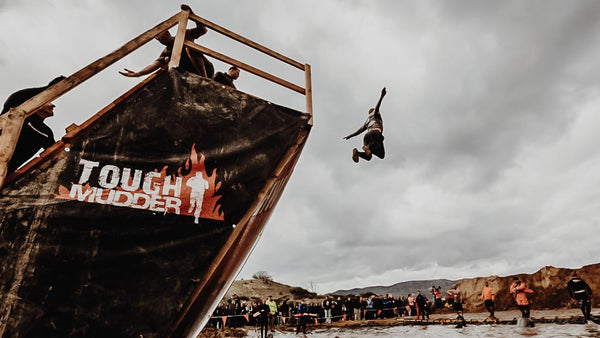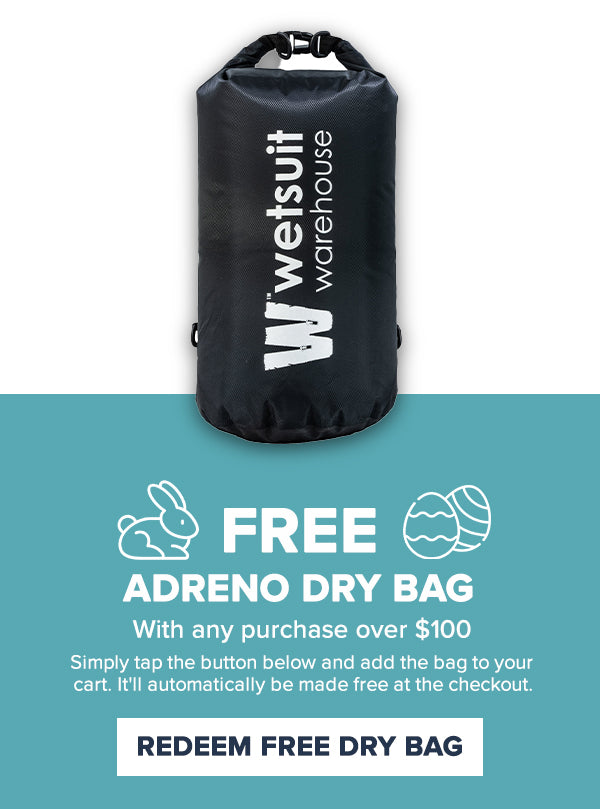Wetsuit guide to Obstacle Course & Adventure Racing - Tough Mudder, Spartan and Muddy Hell OCR
June 20, 2018 6 min read

Obstacle Course Racing [OCR] racing, such as Tough Mudder and Spartan, is growing with increasing popularity and as we begin to see races all-year-round the need for a wetsuit, thermal, or neoprene top and/or bottom, is crucial in order to avoid hypothermia and unnecessary energy wastage. At all costs, we want to avoid the 'Umbles' - stumbles, fumbles, bumbles and worst of all: the grumbles. For your body to maintain core body temperatures in cold conditions it consumes energy to create heat, this energy consumption is certainly warming but takes a direct toll on your performance as you've only got a single, limited energy pool and it's known that shivering increases metabolic rate [energy used/time] up to 5 fold!
This is where deciding which obstacle course racing wetsuit is appropriate becomes a challenge. You want a top, bottom or wetsuit that will keep you well above the shivering threshold, thus minimising unnecessary energy consumption, but the nature of neoprene is such that more warmth = less stretch. Resistance created by the wetsuit itself directly affects our performance, which is why people spend thousands of dollars on high-performance swimming wet-suits, so it's best to opt for high-stretch neoprenes. An Obstacle Racer needs to wear pieces that can modulate warmth, either by breathable seams or fabrics or the ability to un-zip. If you buy an item that is too thick for your requirements, it will inhibit your movement, making everything even harder and you'll be more likely to overheat and burnout.
In OCR we need a wetsuit to insulate our core against the cold air/water outside whilst reflecting heat emitted from our body back towards our body, typically with a tiny layer of water within the suit, but we cover this with great depth in our video guide to thicknesses. This is the basic operating principle of a wetsuit but being that the majority of exposure experienced by an obstacle-course-racer is above water, the most important consideration is resistance to wind-chill, durability and flexibility. Furthermore, in warmer conditions where a wetsuit is nice but not crucial, your OCR suit should be able to breathe ever so slightly, unlike a surfing or diving wetsuit. Lucky for you, breathable flat-lock stitched wetsuits are always cheaper!

Key Features for Obstacle Course Racing Wetsuits
- Core Insulation: Warm vital organs means less energy consumed to maintain core body temperature. Shivering increases energy consumption use 5 fold BUT you don't need be shivering to drastically increase your energy-consumption/metabolic rate [non-shivering thermogenesis for those that are interested...]
- High Stretch: Stretch of a wetsuit is important because it defines the amount of additional work created by the neoprene itself, a low stretch suit creates more work. Neoprene is highly stretchy but pails in comparison to human bodies/skin therefore a wetsuit makes all forms of movement more energy consuming and every obstacle harder.
- Durability: Mud, gravel and dirt are all substantially more abrasive than water, therefore the demands of OCR apparel is different to that of surfing or diving wetsuits. In our collection of OCR gear we have ensured these items have key durability features like Supratex knee panels, durable jerseys and medium-density neoprene. [The lower the density, the more stretch but less durability]
- Wind-Chill Resistance: Being that you're rarely under-water the most important consideration is resisting wind-chill. All neoprene materials, except for 'smooth-skin coated neoprene' will hold a certain amount of water in the external weave. However, smooth-skins are hydrophobic and actually repel water, that means water won't stick to the outside of your suit, therefore drastically reducing wind chill. Generally smooth-skin coats are fragile but we've included only the most durable smooth-skins. I've seen a study that states that when considering the same medium, if it is wet it will lose heat 25x faster than when it's dry, this is why smooth-skins can be so crucial at cold events.

In this picture you can see both standard elastane lined neopre [blue stuff] and the rubbery looking panel is the wind-chill resistant 'smooth-skin'.
Materials in Obstacle Course Racing Wetsuits
- Neoprene: This is the standard wetsuit material and ranges in thickness from 0.5mm to 4mm [in the case of OCR wetsuits for Australians]. Neoprene is basically rubber, making it very warm and a great insulator but can be quite 'stiff' and will resist your movement, in-turn having a negative impact on your power and stamina. Neoprene is the warmest but also the stiffest material one will use in OCR so we often recommend a john style wetsuit whereby there is no neoprene around your shoulders, just your torso and legs.
- Polyfleece: Polyfleece is a new-age technical fibre with high-stretch and hydrophobic properties. A polyfleece top will be both breathable and insulative but will not provide the same thermal protection that neoprene provides. From experience, a combination of polyfleece and neoprene will provide the best results, one that has neoprene around your torso and polyfleece on the sleeves. Bear in mind that even though polyfleece is hydrophobic it will still hold moisture in the weave, meaning wind-chill is harder to combat.
- Lycra: Many of us are familiar with a rashie or a sunshirt and these are typically made of Lycra of Elastane. Lycra has very limited thermal qualities and in certain conditions, where wind-chill factor is high, will actually cool you down more than being naked!

How to choose the right OCR Wetsuit or thermal?
There is no easy answer but thankfully there is no right or wrong! Finding the perfect piece or combination is highly dependant on personal tolerance to the cold, season and location. However, every product you find in our Obstacle Course Racing collection has been hand-picked because it's particularly applicable to OCR and Tough Mudder. Pop into our Brisbane, Sydneyor Melbournestore to have a chat, or hit us on live chat or call one of our stores.
What Style of wetsuit or thermal should I wear in Tough Mudder and Spartan OCR?
The unique demands of obstacle course racing are such that the typical considerations of style go out the window but we've got an extensive blog on wetsuit styles which will help you decide what's best for your racing. Getting back to OCR, the most important thing is retaining core warmth and to limit the additional work created by wearing a restrictive body-suit. Higher quality wetsuits provide more stretch, thus less restriction, but in order to be warm without spending big-bucks we suggest opting for a sleeve-less neoprene suit, typically called a John, long-john refers to the pant-legged version and short-john features short legs. If you're not worried about keeping your legs warm than we recommend a neoprene top which will effectively heat your core without impeding on your performance.
Is there an alternative to neoprene wetsuits for OCR?
There are plenty of non-neoprene solutions, most of which are made with poly-fleece or other hydrophobic [repels water] materials, a bonus to these fibres is they boast impressive 4-way stretch, far greater than a neoprene wetsuit. These items don't provide the same insulation as neoprene rubber because neoprene is, lets say, like a plastic bag: it has very low permeability where as polyfleece is like a green reusable shopping bag, which are leaky and porous. The biggest issue raised by these alternatives to neoprene is that the fibres themselves may be hydrophobic but the weave can retain moisture, this means that every passing breeze will be wicking heat away from your body at a much greater rate than if you were wearing nothing at all. The best thermal products, by a long shot, are the Enth Degree range as they're designed to be versatile and versatility is the nature of OCR - these are the best thermals we've used, in and out of the water. We have included these products in this selection because they're the best option in warm climates, where you're typically hoping to reduce exposure more so than insulate against cold water and mud. They're also the most effective under-garments for use in both dry and wet applications.

What about a neoprene wetsuit top for Obstacle Course Racing?
Wetsuit tops are a fantastic option for Australian Obstacle Course Racers that don't think they 'feel the cold.' In our experience, you may be cold at the beginning but as your body generates heat through exertion your need for warmth is reduced. The advantage that a top presents is that it will insulate your core without negatively impacting how freely your legs can move and allows you to regulate your temps more delicately.
Will I be warm in just neoprene wetsuit pants?
There's not definite answer here as it all depends on your personal tolerance to the cold, the conditions and the course but as an Obstacle Course Racer you're probably well equipped to deal with tolerating discomfort. In saying that, the most important consideration is ensuring your body isn't wasting energy to stay warm when you're waiting to get onto an obstacle, for example. Neoprene pants are highly popular because they are skin tight which means you won't rash like when wearing boardshorts or walk shorts.
How do I stop wetsuit stink?
A wetsuit would be one of the most aromatically diverse products in the entire world, generally resulting from bacterial growth, but the only smell we want coming from our wetsuit is that of Wetsuit Wash.
Leave a comment
Comments will be approved before showing up.


